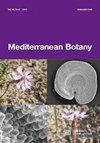马德里和La Sagra地区膨胀粘土的植被(马德里-托莱多,西班牙)
IF 0.7
4区 生物学
Q3 PLANT SCIENCES
引用次数: 0
摘要
在托莱多省,从马德里东部到塔古斯河周围的NNE-SSW的广阔地区,发现了富含膨胀粘土(即蒙脱石和蒙脱石,以及较小程度上的软粘土,如海泡石和斜长石)的土壤。这些粘土往往会形成一种特殊类型的土壤,称为“垂直土”或具有垂直特性的相关粘土,具有不同的化学和沉积成分,偶尔还会形成硅质或白云岩碎屑。在这些缺乏木本植被的土壤中,通过土地的使用和改造,定居的亲氮植被变得特别有趣。这些泥质土壤植物群落非常多样化,植物群适合这些环境独特的水文地球化学条件。这些植物群落的多样性是由土地利用、岩性、地形和它们所能承受的湿度水平等因素决定的。本文确定了马德里-托莱多膨胀粘土上的主要植物群落,并为其不同的品种和向其他相关植物群落的过渡提供了初步的途径。建立了主要的动态和连锁联系,并提供了一个植物区系总结表,以及对社区行为和可变性的描述性检查。最后,对其保护状况和受到的威胁程度进行了评估。本文章由计算机程序翻译,如有差异,请以英文原文为准。
Vegetation on expansive clay soils from Madrid and La Sagra region (Madrid-Toledo, Spain)
Soils rich in expansive clays (i.e., smectite and montmorillonite, and, to a lesser extent, soft clays such as sepiolite and palygorskite) are found in a broad stretch running NNE-SSW from the east of Madrid to the Tagus River surrounds in the province of Toledo. These clays tend to give rise to a specific type of soil, known as "vertisols" or related argillic soils with vertic behaviour, varied chemical and sedimentological composition, and occasionally siliceous or dolomitic clasts. In these soils, where there is an absence of woody vegetation, the colonising nitrophilous vegetation becomes of particular interest through the usage and alteration of the land. These argillic soil plant communities are incredibly diversified, with flora suited to the unique hydrogeochemical conditions of these settings. The variety of these plant communities is determined by factors such as land use, lithology, terrain, and the level of humidity they can withstand. We identify the primary plant community on the Madrid-Toledo expansive clays in this paper, as well as provide a preliminary approach to the different varieties and transitions to other related plant communities. The main dynamic and catena links are established, and a floristically summarised table is provided, along with a descriptive examination of the community's behaviour and variability. Finally, its conservation status and the high degree of threat to which it is subjected are assessed.
求助全文
通过发布文献求助,成功后即可免费获取论文全文。
去求助
来源期刊

Mediterranean Botany
Agricultural and Biological Sciences-Plant Science
CiteScore
2.40
自引率
10.00%
发文量
30
审稿时长
12 weeks
期刊介绍:
Mediterranean Botany (ISSNe 2603-9109), formerly Lazaroa, is a biannual journal that publishes original research studies in the field of Botany including plant systematics, vegetation ecology, biogeography, evolutionary biology, ecophysiology, community ecology, ethnobotany and conservation biology on Mediterranean biomes but also in interacting areas.
Mediterranean Botany is an OPEN ACCESS Journal, free of charges for any published article.
 求助内容:
求助内容: 应助结果提醒方式:
应助结果提醒方式:


